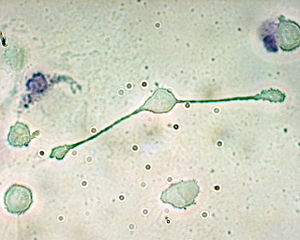Blocking TGF-β-Smad2/3 innate immune signaling mitigates Alzheimer-like pathology.
A new possible treatment target has been demonstrated by a group of researchers working with transgenic mice that are used to model Alzheimer's in humans. According to New Scientist:
"Richard Flavell at Yale University and colleagues created transgenic mice predisposed to develop brain plaques, and doubly transgenic mice that also had a gene that blocks TGF-beta, a chemical used by the immune system."
"The researchers expected the second set to fare worse than the first. But to their surprise, the doubly transgenic mice performed better on various mazes"...
Ads by Google
Posted by ellen at June 06, 2008 08:45 AM

A macrophage of a mouse stretching its "arms" (Pseudopodia) to engulf two particles, possibly pathogens [Obli at en.wikipedia CC-BY-SA-2.0.]

Excerpts from the article:
Blocking TGF-beta-Smad2/3 innate immune signaling mitigates Alzheimer-like pathology.
Authors: Town,Terrence, et al.
Source: Nature medicine, 2008, 14, 6, 681, Nature Pub. Co., New York, NY
The short version (my words): Tg2576 mice [mice used to model Alzheimer's disease in humans] show hyperactivity probably resulting from brain injury related to their disease. The researchers genetically blocked a type of immune system signalling in the Alzheimer's mice and found that it completely mitigated the hyperactivity associated with mouse "Alzheimer's" disease and partially mitigated the memory deficits.
From the article abstract: "Aged doubletransgenic mice showed complete mitigation of Tg2576-associated hyperactivity and partial mitigation of defective spatial working memory. Brain parenchymal and cerebrovascular b-amyloid deposits and Aβ abundance were markedly (up to 90%) attenuated in Tg2576-CD11c-DNR mice. This was associated with increased infiltration of Aβ-containing peripheral macrophages around cerebral vessels and b-amyloid plaques."
"TGF-βs are pleiotropic cytokines with central roles in immune suppression, immune homeostasis and repair after injury. TGF-β1 in brain dampens microglial activation. However, TGF-β1 overexpression promotes brain inflammation, simultaneously accelerates brain vascular b-amyloid deposits and reduces parenchymal β-amyloid deposits, and elicits neuronal Aβ secretion."
"We hypothesized that blocking innate immune TGF-β signaling
would impair cerebral Aβ clearance, but, as detailed below, we found
support for the converse hypothesis."
"Tg2576 mice showed hyperactivity probably resulting from
disinhibition associated with hippocampal or cortical injury whereas
the Tg2576-CD11c-DNR mice showed complete hyperactivity mitigation. ..Similar results were observed during novel Y-maze exploration..."
From the Yale Office of Public Affairs Press release:
Researchers Clear up Alzheimer's Plaques in Mice
"New Haven, Conn. — Blocking a common immune system response cleared up plaques associated with Alzheimer's Disease and enabled treated mice to recover some lost memory, Yale University researchers report Friday in the journal Nature Medicine.
Researchers hope the new approach may one day overcome one of the biggest obstacles to development of new dementia medications – the difficulty in finding drugs that can safely cross the blood-brain barrier.
The results of the research surprised the scientists working in the lab of Richard Flavell, senior author of the paper, chairman of the Department of Immunobiology at Yale and investigator with the Howard Hughes Medical Institute. Flavell's team originally thought that blocking the immune system molecule TGF-Β (or transforming growth factor), might actually increase the buildup of amyloid plaques associated with Alzheimer's Disease
Earlier studies had shown that Alzheimer's patients tend to have elevated amounts of TGF-β, which plays a key role in activating immune system response to injury. Some had thought the presence of the molecule was simply the result of an immune response to the molecular processes that produce plaques.
Instead, the team found that as much as 90 percent of the plaques were eliminated from the brains of mice genetically engineered to block TGF-β.
"It was like a vacuum cleaner had removed the plaques," Flavell said...."
Ads by Google